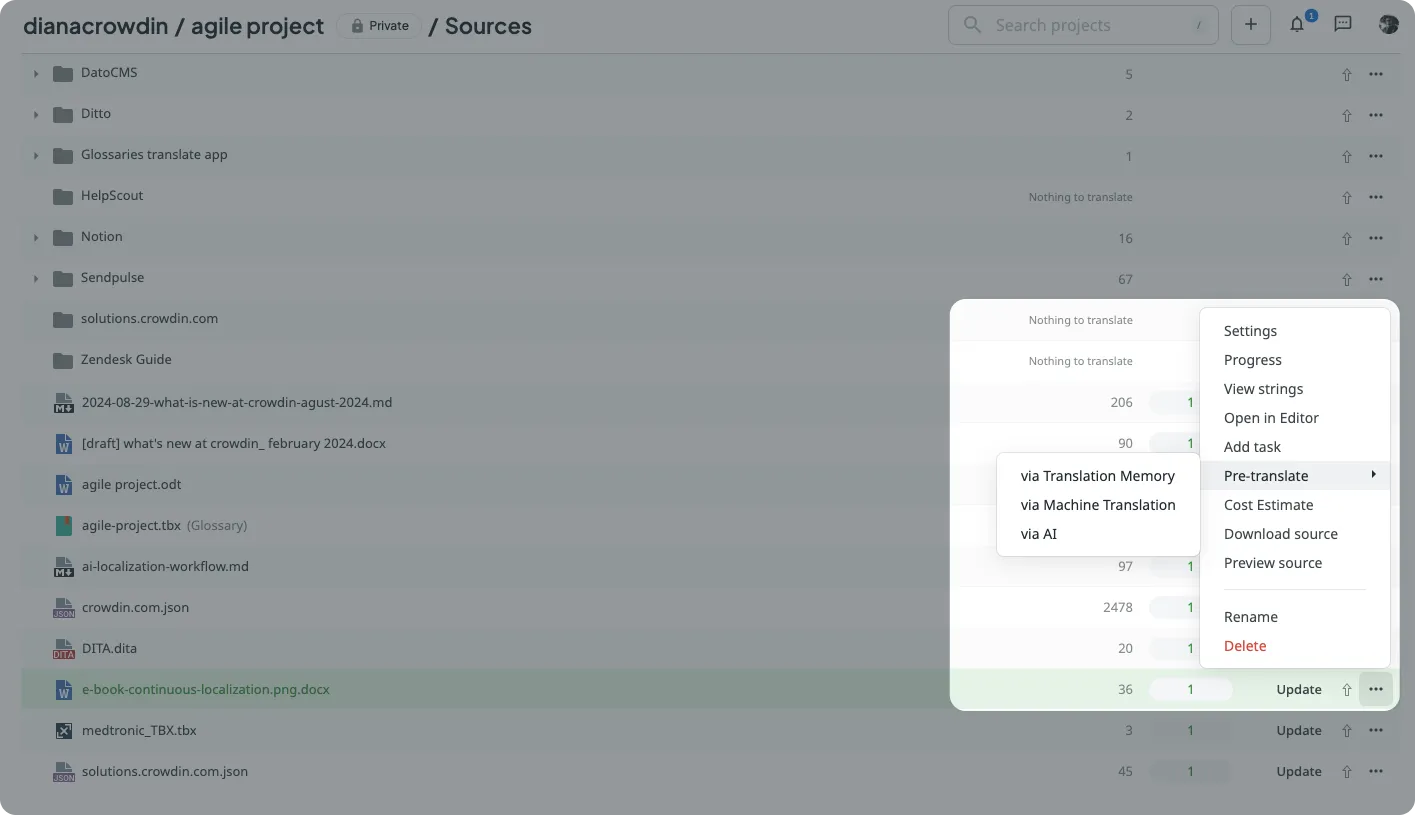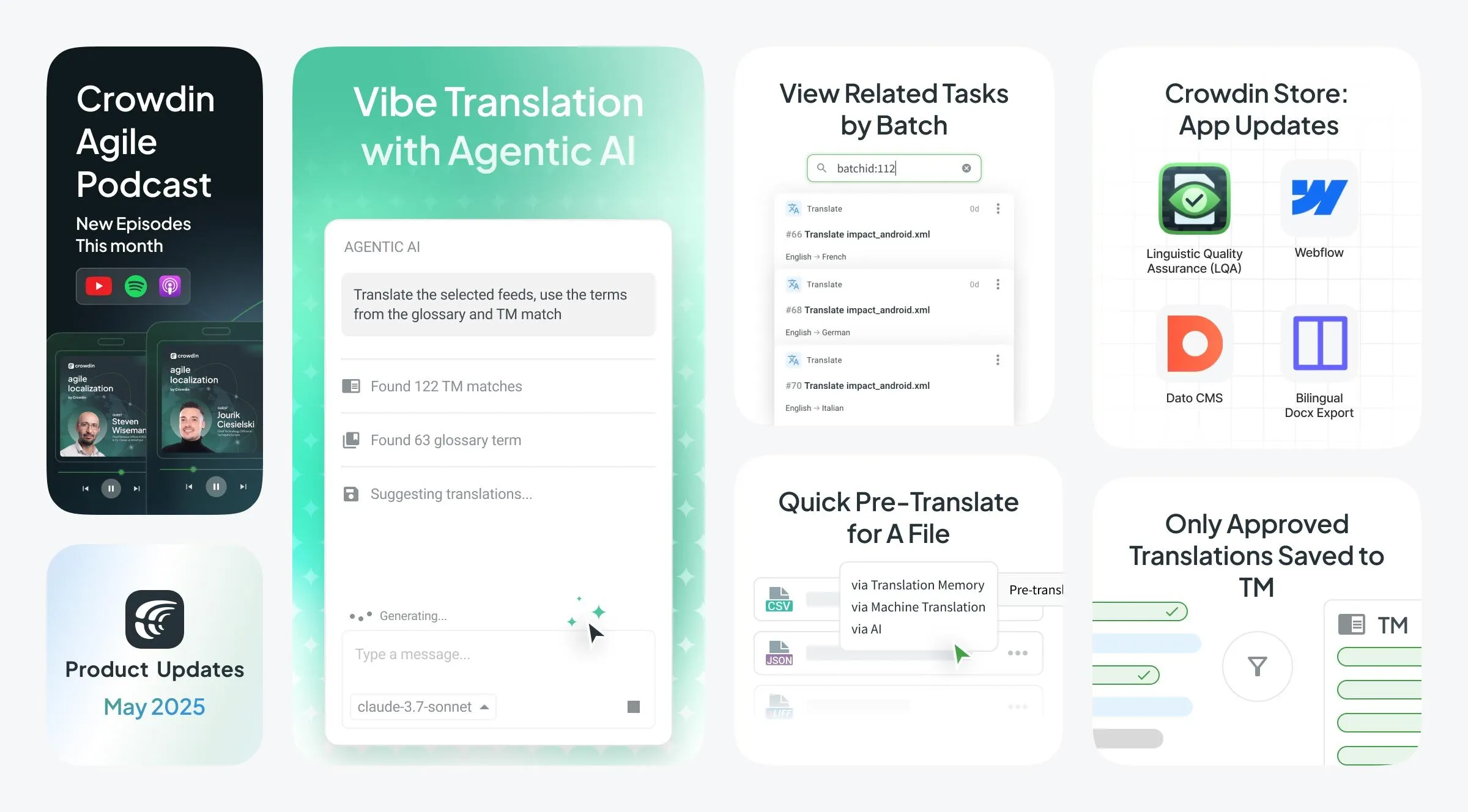In May, we closed 192 tasks and released 430 updates across Crowdin Enterprise and Crowdin.com. The highlight of the month was Agentic AI – a new autonomous system for translation assistance, inspired by vibe coding. It plans, searches, and validates translations like a real team member. In the Crowdin Store, 7 apps were updated, including major improvements to Webflow, Shopify, DatoCMS, and Bilingual DOCX Export. Pre-translation just got faster, filters got more flexible, and AI got more context-aware than ever. Let’s take a closer look.
Vibe Translation with Agentic AI from Crowdin
If you have developer friends or colleagues, you may have heard of vibe coding. It’s an emerging trend in the software development world, where AI helps solve development tasks as if there were no code. This technique is becoming more useful and production-ready as time goes on.
We made one like that, but for translation needs. With this month’s biggest update — Crowdin’s new Agentic AI — we hope to introduce a smarter way to work with AI in localization projects. It’s not just a tool that translates, it’s an autonomous agent that can plan, search, and validate translations like a real team member.
This is what we call Vibe Translation. Inspired by “vibe coding”. How does it work?
Most translation tools still work with plain prompts. You give it a string, it gives you a guess. A guess might be wrong — AI could have made it better, but it was not presented with the context information it needed. Agentic AI is different. It’s able to:
- Access your whole project — files, previous translations, glossaries, and approvals and the ability to interact with it.
- Find product context automatically (from your websites, GitHub projects, Figma designs, CMS, etc.)
- Check itself for logic/formatting/QA issues and fix them.
- Adapt to your team’s specific tools and rules using plugin-based logic (MCPs)
It doesn’t rely on static prompts or one-time outputs. It works as a loop:
understand context → make a plan → validate the output → adjust if needed.
Now, let’s talk more about what MCP is and why we think it’s so important for localization. MCP is essentially an AI toolset. Previously, Crowdin would perform RAG and provide the AI with as much contextual information as possible and then expect a result.
Now, in addition to the existing context, we provide the AI with a toolset, or a set of MCP servers that the AI can use.
Below are a few experiments we set up and their outcomes for different types of projects:
1. Mobile app localization: iOS app whose code is hosted on GitHub.
We set up an AI agent using the GitHub MCP, allowing the AI to access GitHub now.
When a linguist working in the Crowdin editor encounters a key they are unsure how to translate, they can ask the AI for a suggested translation. The AI can then look at the mobile app’s code and show the translator where the key is being used. We intentionally tested GitHub MCP on iOS because localization keys in iOS are technically not used directly in the code. They are used through a file with constants. For example, an “app.about” key would not show up in the code. Instead, the code would show an “appAbout” (or a different) key. This complicates context extraction, and our previous context extraction tool struggled particularly with iOS app context.
The following screenshot shows how the AI Agent with GitHub MCP addressed the issue.

Until recently, this level of quality context extraction was only possible by speaking to a human developer. Now, AI can do this for linguists, or even during automatic pre-translation in Crowdin.
2. Experiment with translating content from a headless CMS.
Translating headless CMS content presents challenges similar to UI localization. Often, small pieces of text are not connected to the context in which they are consumed or published. We configured AI Agent with SERP MCP and HTTP Fetch MCP. The first allows you to search the internet (or a particular website) for uses of a specific segment. The second allows the AI to read the entire page and understand where the text is used.
Context is key to quality translations.
The Reality Check
Setting up these MCP integrations required a lot of effort. It’s not plug-and-play technology yet. There’s also a performance trade-off. MCP-enabled AI translation is noticeably slower. Response times increase dramatically when the AI needs to fetch code from GitHub, search the web, and analyze pages before suggesting a translation.
Why We’re Still Optimistic
Despite these limitations, we see this as major progress toward higher-quality AI translation. This approach mirrors how human translators work: they research the context and verify their choices. AI agents just do it faster, even with the current slowdowns.
Note: We’re currently preparing to launch a new category in the Crowdin Store: MCPs for localization needs. This category will grow over time. Right now, clients can bring their own Self-Hosted SSE MCPs, and soon the most popular MCPs will be plug & plan. So, we encourage everyone to start experimenting with MCPs today, rather than waiting for the official category launch. Ready to try it? We’d love to hear your feedback and ideas to keep improving it. Install Agentic AI on Crowdin.
Crowdin Store: App Updates
Here are the latest improvements to apps in the Crowdin Store:
- LQA Reporting Across Projects
You can now generate LQA reports for multiple projects with a single API call. This is especially useful for teams managing many projects and needing consistent reporting. - Webflow Forms Sync
The Webflow app now supports syncing form content for translation in Crowdin. - DatoCMS Context Enhancements
Field and item names from DatoCMS are now included as context, helping AI and translators better understand what they’re working with. - Improved Shopify Export
Translations are now mapped to language codes instead of list positions. This prevents mix-ups and makes the export process more predictable. - Multi-File Selection with Ctrl / Shift
You can now select multiple files using Ctrl or Shift. This speeds up partial syncs and reduces the number of clicks when you’re working with lots of files. As usual, improvements in integrations roll out with a slight delay. Already available in Contentful, Webflow, DatoCMS, and Zendesk integrations.
New Import Feature in Bilingual DOCX App
The Bilingual Docx Export app now supports not only exporting but also importing DOCX files, with enhanced control over formatting during both export and import.
This is especially important for translators working with Asian languages, where standard spell checkers often do not function properly. While we recommend AI-based QA checks, many linguists prefer working directly in Microsoft Word. Their workflow typically involves translating in CrowdIn with basic QA, exporting the Word document, running spell check in Word, and then importing the document back.
Previously, the app only supported export, limiting this process. The new import capability enables a full two-way workflow with Word documents, significantly improving QA options for Asian language translations.
If your linguists have requested better spell checking tools for Asian languages, this app can meet those needs. We recommend considering the app installation.
Quick Pre-Translate for A File
We’ve added a faster way to pre-translate a single file. Just find the file you need, click the three dots menu, and choose Pre-translate. You can then pick your preferred method: Translation Memory (TM), Machine Translation (MT), or AI.

Localize your product with Crowdin
Download Filtered Terms
The new update allows you to download a filtered set of glossary terms based on specific criteria — such as date range or status. This is useful when you want to review or work with a subset of terms offline or outside Crowdin.

Only Approved Translations Saved to TM
Choose to save only approved translations to your project’s Translation Memory. This helps maintain higher quality and consistency by filtering out unreviewed or draft content. The option can be enabled in your project settings under the Translation Memory section.
Label Filter Logic: AND / OR Support
Thanks to our new update, you can now choose how label filters behave — either match all selected labels (AND) or any selected label (OR). This applies both when filtering strings in the Editor and when creating tasks.
Filter Tasks You Created Together
You can now identify tasks that were created together in the same batch. This is useful for filtering and applying bulk actions to related tasks. Just open the task menu (three dots) and select Tasks Created Together --- they’re grouped by batchId.
New on The Agile Localization Podcast
This month, we released two new episodes exploring where localization is headed and how to make AI content more efficient:
What’s Next for Localization with Jourik Ciesielski
CTO of Yamagata Europe, Jourik Ciesielski, talks about how localization must evolve. He shares his take on redefining quality in the age of GenAI, improving QA processes, and why translation should focus on delivering complete user experiences.
Cut Your AI Content Costs by 50% with Steven Wiseman
Steven Wiseman, CRO at WritePoint, presents the Content Excellence Framework — a method to boost the quality of AI-generated content while significantly cutting costs. He explains how to bring structure and consistency to AI workflows in real-world teams.
Listen to the episodes on Apple Podcasts, Spotify, or YouTube.
API Updates
- QA Issues API: Added filters for specific files and tasks to make issue tracking more precise.
- CroQL: You can now filter by BranchId to narrow down results by branch.
- Pre-Translation Report API: New endpoint to generate reports after pre-translation. It shows segments that couldn’t be translated automatically, explains why, and helps identify issues before the full translation starts.
Other Small Updates
- More context for Custom Code in workflows — You now have access to additional data when writing Custom Code steps in workflow automation.
- TM author visibility in Editor — You can now see who added a translation from Translation Memory directly in the Editor.
- Improved shortcode import for Markdown — Better handling of shortcodes when importing .md files.
- Unity Plugin update — In the “Push string translations to Crowdin” dialog, there’s now a checkbox “Auto approve imported”, which lets you automatically approve translations as they’re pushed.
External Tools
In May, we released new versions of:
- JS API Client 1.43.0, 1.44.0
- Java API Client 1.26.0
- Python API Client 1.23.0
- .NET API Client 2.35.0
- Go API Client v0.15.0
Localize your product with Crowdin
Diana Voroniak
Diana Voroniak has been in the localization industry for over 4 years and currently leads a marketing team at Crowdin. She brings a unique perspective to the localization with her background as a translator. Her professional focus is on driving strategic growth through content, SEO, partnerships, and international events. She celebrates milestones, redesigns platforms, and spoils her dog and cat.
